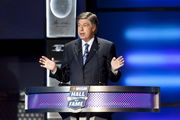
via Imago
DAYTONA, FL – FEBRUARY 18: William Byron Jr. 24 Hendrick Motorsports Axalta Chevrolet leads teammates Kyle Larson 5 Hendrick Motorsports HendrickCars.com Chevrolet, Chase Elliott 9 Hendrick Motorsports NAPA Auto Parts Chevrolet, and Alex Bowman 48 Hendrick Motorsports Ally Chevrolet during practice for the Daytona 500 on February 18, 2022 at Daytona International Speedway ion Daytona Beach, Fl. Photo by David Rosenblum/Icon Sportswire AUTO: FEB 18 NASCAR, Motorsport, USA Cup Series – DAYTONA 500 Practice Icon220218116110 | Image Credits: Imago

via Imago
DAYTONA, FL – FEBRUARY 18: William Byron Jr. 24 Hendrick Motorsports Axalta Chevrolet leads teammates Kyle Larson 5 Hendrick Motorsports HendrickCars.com Chevrolet, Chase Elliott 9 Hendrick Motorsports NAPA Auto Parts Chevrolet, and Alex Bowman 48 Hendrick Motorsports Ally Chevrolet during practice for the Daytona 500 on February 18, 2022 at Daytona International Speedway ion Daytona Beach, Fl. Photo by David Rosenblum/Icon Sportswire AUTO: FEB 18 NASCAR, Motorsport, USA Cup Series – DAYTONA 500 Practice Icon220218116110 | Image Credits: Imago
Today, NASCAR is not remotely what it used to be in the late 1990s or the early 2000s. Indeed, the need for speed has remained constant. However, it’s safe to say that the sport has changed a lot in terms of its nature, rules, and regulations. But the most notable change is in its cars. NASCAR has been spending countless hours devising ways to level the field in order to ensure fair competition.
Back in the days of legendary NASCAR icons like Jeff Burton and Sterling Marlin, the competition was not as fair as it is today. The Gen-5 cars, also known as the “Car of Tomorrow”, could be tweaked to certain limits, and that often led to a considerable performance advantage. But what if someone cuts a fine specimen of the Car of Tomorrow, better known as CoT, in half and puts it up for sale? Wouldn’t it be something that any motorsport enthusiast wants to own?
ADVERTISEMENT
Article continues below this ad
The half-naked car is up for grabs
When a Stewart-Haas Racing insider revealed the naked truth behind the stock car, many were astonished by it. Now, anyone can keep a spectacular prototype of that car, showing its insides. And that too for $1000 (for now as prices may rise according to individual biddings).
The orange and white Toyota Camry was fueled by a Ford Small-Block V8 engine (which has been removed), a four-speed manual gear transmission case with 15″ chrome aero race wheels, fire-suppression system components, butler-built seats, and pro-comp gauges. This is exactly what a racing fanatic might want to lay their hands on. Indeed, this is a once-in-a-lifetime offer. And just the way in which it is cut in half makes it unique.
Needless to say, the mechanical components have been removed from the engine, transmission, and rear end. This NASCAR CoT cutaway replica is now offered for sale at no reserve in Petal, Mississippi. This car was originally constructed in 2010 as a replica of Greg Biffle’s #16 3M Ford Fusion. This machine-turned-collectible was first displayed at the Ford display booth at the 2010 Woodward Dream Cruise in Detroit.
Watch this story: NASCAR’s 2024 Schedule: A New Chapter Begins
Later, it was bought off by Texas Motor Speedway and painted in a #44 Whataburger Toyota Camry livery vinyl skin and driven by David Starr for TriStar Motorsports in the 2014 NASCAR Nationwide Series Season. Although a collector’s item now, it’s interesting to know how these “Cars of Tomorrow” were a nuisance to today’s bigshot teams like Chevrolet back in the late 1990s.
Trending
There was a time when the Fords dominated the Chevys, thanks to CoT
Before the usher of the new generation of cars, teams could make changes here and there in their cars to leverage advantages based on the body’s shape. For decades, the teams have been complaining about the same. To name a few of the many, the 1970 Plymouth Superbird, the 1981 Pontiac Le Mans, and the 1985 Ford Thunderbird are perfect examples. Sam Hornish’s skew car from the 2008 All-Star race made the highlights by finishing 7th after overcoming a two-lap deficit. All of these cars forced NASCAR to write new rules to level the playing field.
One of the biggest outrages came in 1998 when the Ford Taurus was introduced. The story of how the Fords were able to trick NASCAR with a fake prototype to their advantage has been detailed by a NASCAR insider. After just 3 races into the 1998 season, everyone started believing that the Fords would dominate the entire field throughout the entire season.
Ford won 13 of the top 14 spots at Las Vegas that year. According to the industry insider “nascarman,” Chevrolet complained about how unfair the competition was. On that note, the talks revolving around the car were so outrageous that NASCAR responded by cutting a quarter of an inch off the spoiler to reduce the downforce for the Ford Taurus.
ADVERTISEMENT
Article continues below this ad
A car so innovative that NASCAR quickly banned it: Sam Hornish's skew car from the 2008 All-Star race. The rear end was angled far more than others to create more side force. Hornish overcame a two lap deficit to finish 7th. pic.twitter.com/i1WcJLC38y
— nascarman (@nascarman_rr) May 17, 2021
However, the main reason why the Ford Taurus was so significant as a CoT was that, it’s due to the sheer dominance of this car that NASCAR was forced to think about a model of a car, that would be the same for every driver. This ultimately snowballed into today’s stock cars.
ADVERTISEMENT
Article continues below this ad
When one turns over the pages of NASCAR history, one would perhaps come across more stories like this one. And anecdotes like these are enough to make anyone develop an interest in car racing. Don’t you agree?
Read more: Should NASCAR Continue Running on Road Courses or Limit Itself to Oval Layouts?
ADVERTISEMENT
ADVERTISEMENT
ADVERTISEMENT
ADVERTISEMENT







